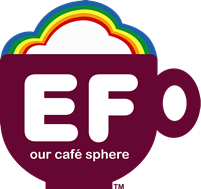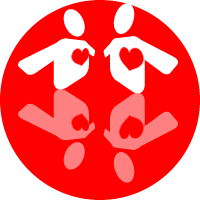EXTRA FOAM
I had practically lived in coffee houses while I was a university student. With cafés and coffee houses, the economics of relatively inexpensive beverages served for an open public space in which to sip them fascinated me for its value, simplicity and diversity: it was a so-called third place between home and work, or school. In American society, comprised of people increasingly polarized and isolated – alienated – I deeply appreciated the custom of sitting (often in close quarters) with co-inhabitants of my city. I observed the variety of conversations happening around me, entering my subconscious, even informing me in an ambient way: students discussing their subjects, women discussing their marriages, local manifesto-writers planning their coups (perhaps by themselves), business people talking shop, elderly folks in sage discourse, et cetera.
Third places shared an obvious similarity with the web. As I read up on the history of social discourse in the West, I learned that in fact the basic phenomenon of the ‘social sphere’ and ‘public opinion’ was intimately tied to coffee houses (as sociologist Jürgen Habermas had famously pointed out). The rise of third places was contemporaneous with the Western adoption of coffee and tea products (in that order), colonialism and chartered corporations, the Sciences, the free press, democratic prerogatives and artistic revolutions (like Modernism). It was even claimed that a coffee house and the internet were socially and historically cognate: essentially on the same cultural continuum but differing only in technological magnitude. I was rather shocked to find out that the first coffee house opened in London around 1650 – this conflicted with the ubiquity and seemingly primordial presence of coffee in our age (whereas Shakespeare never drank a cup), and at the same time coffee-drinking was a surprisingly old social practice indeed (so much older than Starbucks, et al).
It dawned on me that the Third Place was an indispensable and vital social technology, a unique psychogeography that must be saved from corporate colonization or public apathy. I wanted to inform people about this cultural treasure. That’s how Extra Foam started (its name derived from the quirky request to baristas for more foamed milk in a drink). With this project I would help people go to coffee houses more frequently – in the process helping the owners stay in business – and improve their sociability while enjoying third places. A concise directory would be offered, listing all of the ‘watering holes’ in the city and categorizing them according to how conducive they are to particular social discourses and activities. The interface would educate users all the while, about the history of the social sphere.
See some early press about EF in Boulder, CO, USA.
The next step in this idea involved creating a fairly simple application on the website so that registered members could basically plot themselves on a dynamic map and thereby alert their friends and associates of a precise location, an empty seat beside them. Or, the interface would encourage the be-friended members to make plans to meet, and help them select the right space according to its characteristic mood. One would not select the same coffee house, for instance, to take a date as one would for a business colleague.
The sophistication of web technology (e.g., open source social networking code), and prolific social networking sites, not to mention Google Maps, has made the Extra Foam concept much simpler than it seemed when I made the mock-ups in early 2008. As a business plan, this kind of portal would easily attract plenty of local advertisers (we would expect), such as the coffee houses themselves, as well as related products and services. In fact, a range of sponsored listings (a la the city-guide sites like Yelp) would also produce revenue to run this venture. Best of all, these commercial interests would enjoy a win-win proposition, while preserving a wonderful social phenomenon with rich history.
Now, from my 2009-point of view, inspired by learning about how Mediamatic is empowering grassroots RFID applications, its is thrillingly conceivable that Extra Foam could actually offer a dynamic personal-tracking system for patrons of third places (so that each RFID-toting member of the social network could activate and deactivate their presence in the psychogeographical topology with a simple txt message to the site). The beauty of this potential system, for me, is that no entirely new infrastructure needs to be built (in the case of most cities), and by simply taking full advantage of a concrete network of extant places, applying a little web magic, a powerful social technology might rise again to recharge the social sphere.
[HyperJournal]
The idea here (‘HyperJournal’ is meant to be a generic and tentative name), is to steer social networking in the opposite direction than the mainstream goliaths of this web genre push it: instead of census-like databases and promiscuous ‘friending’, why not provide tiny networks for only our closest confidantes?
Social networks do, of course, come in all shapes and sizes; presently there are already niche sites for media theorists (Rhizome and EBR – and in the beginning, there was The Well), as well as for traveling expats (Matador), hobbyists of all stripes, and probably inestimable other cliques.
But HyperJournal would not center upon a preferred interest or identity, and rather it would encourage its micro-networks to reflect upon Life itself: existence, mortality, metaphysics, spirituality and ‘ultimate concern’. I am thinking that this manifestation of social networking would simultaneously facilitate self-knowledge (in the form of diary-writing within a multimedia environment, replete with a microphone and webcam), and ultra-intimate discourse with our very closest friends.
Whereas Facebook alerts us about the ‘highlights’ from other people’s lives, as in their subscriptions and worldly activities, HyperJournal could unobtrusively share certain permissible personal themes, emotions and thoughts (along with captured media contents) amongst its small networks. The hyper-deflated concept of ‘friends’ would gain a practical environment in which to flourish again, nourished by the meaningful constraints of special interpersonal boundaries (exclusive, but in a natural and healthy way).
As far as I can see, HyperJournal would have to be either a subscription service or an entirely free social service, absolutely devoid of advertising, phishing vulnerabilities, data mining, user profiling, et cetera. Users of this network would also need the ability to backup their journalings on a local machine, as well as the power to instantaneously delete their records on the database in a discrete and permanent way. HyperJournal, in other words, would exist by necessity as the ultimate foil to a commercially-oriented social network, and more akin to a public psychological-health program.

